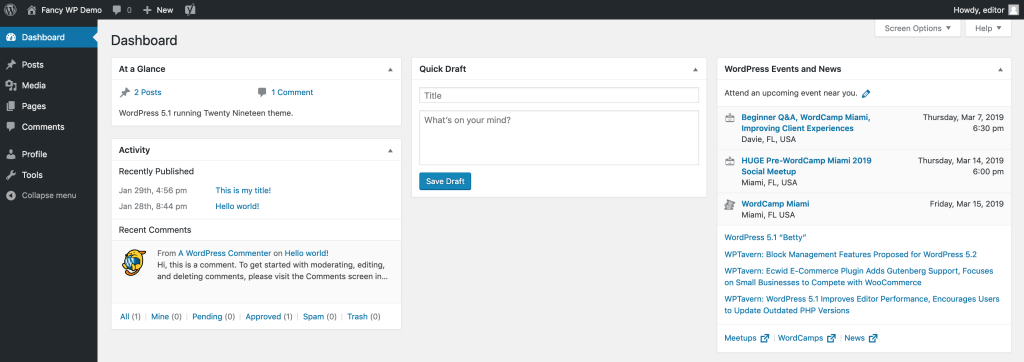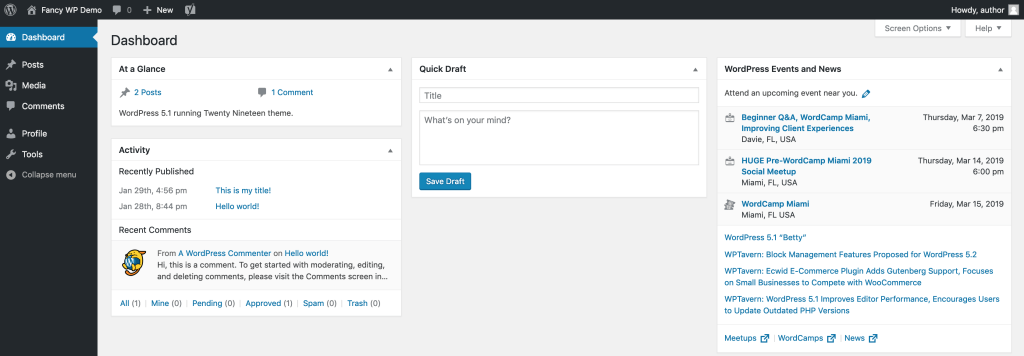WordPress user rolesIn WordPress, a user role is a set of permissions that determines what actions a user can perform on a website... More help you control how your users interact with your website and what specific actions they’re allowed to take.
By assigning appropriate user roles, you can limit the editing privileges of your users and keep your WordPress site secure.
In this guide, we’ll take a look at each of the default user roles, how to apply them effectively, and how to create custom user roles that better suit your individual website.
Default WordPress User Roles
A standard WordPress site has five default user roles:
- Administrator
- Editor
- Author
- Contributor
- Subscriber
If you’re running a WordPress MultisiteMultisite is a feature of WordPress that allows a user to create and manage multiple websites from a single Wo... More network, you will also have the Super Admin role.
Let’s take a closer look at each of these roles and what capabilities they provide.
Administrator

Summary
On a standard WordPress site, Administrator is the most powerful user role, and it’s what you’re assigned when you create a new website.
The Administrator role is generally reserved for site owners and should rarely be assigned to other users.
Administrators have full control and can manage all aspects of your WordPress site.
Capabilities
- Create, publish, edit, and delete any content
- Customize themesA WordPress theme is a set of files that determine the design and layout of a website. It controls everything ... More
- Import and export content
- Add, manage, and delete users (including other administrators)
- Install, activate, and delete plugins and themes
- Install core, pluginA plugin is a software component that adds specific features and functionality to your WordPress website. Esse... More, and theme updates
- Edit code
Editor

Summary
Editors can manage all the postsA post is a type of content in WordPress, a popular open-source content management system used for creating an... More and pagesIn WordPress, a page is a content type that is used to create non-dynamic pages on a website. Pages are typica... More on your site, including those written by others. Editors often oversee the work of authors and contributors.
While editors have a high level of access, they cannot manage global site settings, plugins, themes, or users.
Capabilities
- Create, publish, edit, and delete any posts or pages, including those created by others
- Upload media attachments
- Manage categoriesIn WordPress, categories are a fundamental taxonomy used to group and organize posts based on their topics or ... More
- Moderate commentsComments are a feature of WordPress that allow users to engage in discussions about the content of a website. ... More
Author

Summary
Users with the Author role can write, edit, and publish their own posts, but they can’t edit others’ posts or make any administrative changes to your site.
Capabilities
- Create, publish, and edit their own posts
- Upload media attachments
Contributor

Summary
The Contributor role provides limited capabilities for content creation. Contributors can create and edit their own posts, but they can’t publish their own posts or upload media.
Capabilities
- Create and edit their own posts
- Submit posts for review by an editor or administrator
Subscriber

Summary
The subscriber role is extremely limited, and most sites won’t use it at all. However, it can be useful if you run a membership site or require users to log in to read your content or leave comments.
Capabilities
- Read content
- Update profile
Super Admin

Summary
The Super Admin role is only available to WordPress Multisite networks.
The Super Admin can make network-wide changes and add or delete sites. They can also manage the entire network’s users, plugins, themes, and so on.
On a Multisite network, standard Administrators cannot install updates, manage plugins or themes, edit code, or manage users. All of these capabilities are reserved for the Super Admin.
Capabilities
- Add and delete network sites
- Create, publish, edit, and delete any content
- Import and export content
- Add, manage, and delete users (including other Super Admins)
- Install, activate, and delete plugins and themes
- Install core, plugin, and theme updates
- Edit code
Customizing WordPress User Roles
The default user roles provide a decent framework for assigning permissions to your users, but they’re pretty rigid.
If you want to have greater control over your site’s user roles, you can use the User Role Editor plugin.
This plugin allows you to edit the capabilities of the default user roles, or even create an entirely new role with the capabilities of your choosing.
For example, you could give contributors the ability to upload media to their posts, which isn’t supported by default. Or you could add a new “Comment Moderator” role to have someone manage your comments for you.
Best Practices For Assigning User Roles
As we’ve seen, one WordPress user could have virtually no capabilities, while another could have absolute power over every aspect of your site. When it comes to applying user roles, a little caution and common sense goes a long way.
- Don’t overuse the Administrator role. Most WordPress sites only have one administrator. If you must give someone else this role, make sure it’s someone you trust.
- Only give users the permissions they need. Your authors probably don’t need to edit others’ posts, and your editors don’t need to install plugins. The more superfluous capabilities people have, the greater the chance something will go wrong.
- Start writers off with the Contributor role. This gives you the opportunity to sign off on their work before it’s published. You can always promote them to the Author role later.
- Don’t be afraid to customize your user roles. Every site is different, and every team is different. Give your users the capabilities they need, without the ones they don’t.
If you have any questions about WordPress user roles, please feel free to leave them in the comments below!



